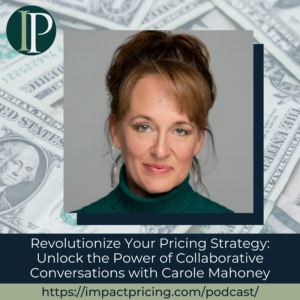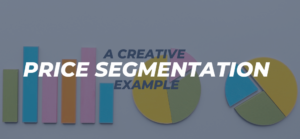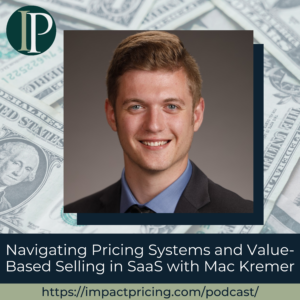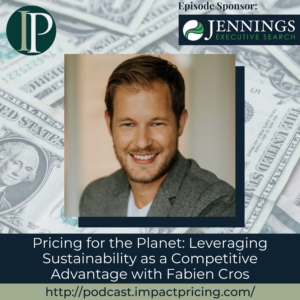Carole Mahoney is an author, speaker, coach, and trainer taking a cognitive approach to sales success.
In this episode, Carole shares how salespeople should initiate a pricing conversation that should be ‘Not Be About Me’ and quantify the cost of not doing something. That way, buyers make a decision for fear of negative business impact.
Podcast: Play in new window | Download
Why you have to check out today’s podcast:
- Discover a powerful pricing conversation technique that focuses on addressing potential objections and inspires people to take action by tapping into their fears of negative outcomes
- Find out how salespeople add value and uncover urgency for people to make a decision
- Understand why salespeople need to create a ‘dirty laundry list’ and include them in their conversation
“The biggest piece of advice for finding value in a conversation and talking about pricing is to make it a collaborative conversation.”
– Carole Mahoney
Topics Covered:
01:30 – How she found a career in pricing
02:20 – Salespeople find it uncomfortable talking about money and pricing matters
03:46 – Pricing conversation that’s more about contrasting and quantifying the cost of doing nothing
06:36 – Not articulating enough the fear of loss
07:49 – Letting buyers articulate the real problem [and getting them to ask these important questions]
08:36 – The Seinfeld-comedy-series inspired technique of pricing conversation
10:16 – Adding value and uncovering urgency
11:30 – Creating a dirty laundry list
14:17 – What makes it advantageous for salespeople to share their laundry list amongst themselves
15:48 – Providing measurable business value while addressing potential negative outcomes
16:59 – Creating a constant reminder to salespeople with a t-shirt that reads: Not About Me
20:43 – Pricing advice that can have the biggest impact in one’s business
Key Takeaways:
“If selling is an exchange of value, then the pricing conversation is the proof of value actually exists.” – Carole Mahoney
“Ask questions that address why they might say no, not why they might say yes, you need both. You need to be able to draw the contrast.” – Carole Mahoney
“It’s not necessarily the salesperson’s job to make it painful to the buyer. It’s the salesperson’s job to ask the questions to uncover if the pain to the buyer is great enough to take action, to make a decision and then to implement a solution.” – Carole Mahoney
People / Resources Mentioned:
- Buyer First: Grow Your Business with Collaborative Selling by Carole Mahoney: www.unboundgrowth.com/buyer-first-book
Connect with Carole Mahoney:
- LinkedIn: https://www.unboundgrowth.com/
- Website: https://www.unboundgrowth.com/
Connect with Mark Stiving:
- LinkedIn: https://www.linkedin.com/in/stiving/
- Email: [email protected]
Full Interview Transcript
(Note: This transcript was created with an AI transcription service. Please forgive any transcription or grammatical errors. We probably sounded better in real life.)
Carole Mahoney
The biggest piece of advice for finding value in a conversation and talking about pricing is to make it a collaborative conversation.
[Intro]
Mark Stiving
Welcome to Impact Pricing, the podcast where we discuss pricing, value, and the buyer’s relationship between them. I’m Mark Stiving. And our guest today is Carole Mahoney, and here are three things you want to know about Carol before we start. She runs a group called Unbound Growth, and she’s been doing that since 2014. She is a sales coach at Harvard Business School, which sounds really impressive. She has a new book coming in September this year titled, Buyer First: Grow Your Business with Collaborative Selling. Oh, and she sings opera. Welcome, Carole.
Carole Mahoney
Thank you so much for having me. Every time I tell people I sing opera, I always feel that now they’re going to expect me to sing opera, aren’t they? So I don’t tell a ton of people, but now the cat’s out.
Mark Stiving
So I thought about asking, but then I said, no, probably not. You’re in my ear. As I said earlier, it might hurt.
Carole Mahoney
It might hurt when my kids were little and I have to call them for dinner or call them to do something. I always did it in the operatic voice because that’s what seemed to get their attention. And so when they would have their friends come over, they would always ask like, mom, can you call so-and-so in the voice? So that’s how I get my practice runs in.
Mark Stiving
It’s called The Voice.
Carole Mahoney
The Voice. Mom, do the Voice.
Mark Stiving
Nice. I normally stop my podcast off by asking the question, how did you get into pricing? So I’m still going to ask you that question, but, we all know that you’re not actually a pricing person. So how did you get into pricing?
Carole Mahoney
Well, I got into pricing because I got into sales, and one of the things that I’ve actually started actively honing for myself is being more comfortable talking about pricing, talking about money, how that conversation flows. Because one of the things that I have found is that when salespeople get into conversations and they have to quantify, they have to talk about money, they have to talk about pricing, most of them somehow opt out of the conversation. And so this was an area that I was seeing happening a lot with my coaching clients in being able to talk pricing because they were uncomfortable talking about money. In fact, you might be surprised to hear that 55% of salespeople are uncomfortable talking about money, and so therefore that’s impacting how they talk about pricing.
Mark Stiving
Why do you think that is? And by the way, do you think they’re uncomfortable talking about money, or do you think they’re uncomfortable talking about pricing?
Carole Mahoney
I think they’re uncomfortable talking about money, which leads to them being able to be comfortable talking about pricing.
Mark Stiving
And what’s the difference?
Carole Mahoney
I think the difference is talking about money are things like, it can be anything from what your goals are and how their finances meet that, it can be what their budgets are or what return on investment might look like. Like what type of return are you comfortable with if you invest this kind of money. And then that leads to the pricing conversation. And the pricing conversation is, I call it the proof of value. If selling is an exchange of value, then the pricing conversation is the proof of value actually exists. You probably hear a lot of buyers say, I see the value in this, but I just can’t pay for it. That means that they don’t actually see the value in it if they’re not willing to pay a price for it.
Mark Stiving
Yeah, absolutely. I love the phrase the proof of value. I think that’s an awesome phrase. When I think about selling though, I do a lot of conversations with potential clients or people about ROI and how much are you going to make when you solve this problem. And for some reason, those feel really comfortable to me. And even as a pricing expert, I still get a little twinge of, Ooh, when I say my fee is whatever it is. Right? And so to me it feels different. Now, I could imagine if you’re uncomfortable talking about money, you’re definitely uncomfortable talking about pricing.
Carole Mahoney
Yes. And also, I think a lot of sellers are more comfortable talking about return on investment. If you invest this money, then you’ll get this kind of a return. But the conversation that they really need to be having is, if you don’t do this, what is the consequences? What is the impact that that has? And how do we quantify that? So what’s the cost of doing nothing is a lot of times more motivating than the cost of what they might actually gain or achieve.
Mark Stiving
Okay. What’s the difference?
Carole Mahoney
The contrast, there’s a contrast between the two.
Mark Stiving
There absolutely is. But let me ask the question this way. I have a product. My product solves a problem. I walk into a company and I say, hey, do you have this problem? They go, yeah. I say, if we solve this problem, what’s the value? And we go through the calculations. By the way, the conversation isn’t quite that simple, but that’s the gist of it, right? So what’s the value of solving the problem? And the implicit differentiation is it’s solving the problem relative to not solving the problem. Now, are you adding something on top of that that I’m not understanding yet?
Carole Mahoney
Yeah. And so instead of making it implicit or implied or assumed, is to actually have a quantifiable contrast between if you do invest this money, your return on investment means that you’re going to have X more in revenue by the end of this year. If you don’t invest this money though, not only are you not going to get that revenue, but there’s also a consequence or a cost to not achieving that revenue. You have to lay people off, or you have to change your own pricing, or, you lose market share, or your retirement gets cut because you didn’t get that bonus. There’s a consequence to doing nothing. And it isn’t always the same as the achievement of a particular ROI.
Mark Stiving
Oh, can I say that’s brilliant?
Carole Mahoney
It is brilliant. Unfortunately, I don’t think I’m the only person who’s thought of that, or the first person to think of that.
Mark Stiving
So it surprises me that I’ve never thought of that before. Not made it up, but it surprises me that I’ve never heard anybody talk about that before. Essentially what you’re saying is, although the gain, we can all quantify what that gain is and what those benefits are. We rarely articulate what’s the pain of not getting it
Carole Mahoney
Right.
Mark Stiving
And that pain, the pain of not getting it is important to our buyers. And in fact, if you think about prospect theory, that tells us that losses loom larger than gains. And the fact that we’re pointing out to them, hey, you’re going to lay people off, you’re not going to hit your quota, you’re not going to, whatever the heck it is, that’s powerful.
Carole Mahoney
And if you think about it, when we talk about ROI with our buyers and that we’re hoping against hope that they’re going to believe that this is the ROI, that this is the thing that we need to achieve. But what a lot of times what people are making or taking action on is the fear of loss or consequences if they don’t do something. And if you look at the numbers and the research, the majority of deals that don’t happen today happen not because they went with a competitor with a different price, but because they chose to do nothing.
Mark Stiving
Yeah. So I always assume the ‘chose to do nothing part’ has to do with the fact that they didn’t value the solution, they didn’t think the problem was big enough to go solve it. So now let me rephrase what you said in slightly different terms then. God, I love having these conversations. What we could do is say, let’s re-articulate the problem. And so the problem is not only, hey, here’s this problem you have to solve, but the problem is also you want to make sure you don’t get fired or you don’t have to lay people off or you.. And so all of these are real problems that we may not think about articulating in the sales cycle.
Carole Mahoney
Right. Even better. If you have your buyers articulate it and you’re asking the questions, what happens if you don’t do this? What happens if this particular thing, this comes to pass? And then here’s the thing that nobody asks is, okay, is that really that big of a deal? Is it the end of the world? Is there no moving on from that? Is that really that bad that you have to take action on it? Because that’s the question buyers are asking themselves, do I really need to do this? Do I really need to do this now? And why do I need to do it with this solution?
Mark Stiving
How do you teach people this? Teach me, by the way. How do you teach people this?
Carole Mahoney
Have you ever watched the Seinfeld comedy series?
Mark Stiving
I have seen Seinfeld.
Mark Stiving
I watch a lot of them, but…
Carole Mahoney
There’s an episode that’s called The Summer of George. And this is the technique a lot of times that I use with salespeople when I’m coaching or teaching or training them, is, if you think of, this is not our natural reaction. As salespeople, we want to find a problem that we can solve and then sell them on the solution and the upsell of that, or the ROI of that. And we tend to avoid those bad things because we don’t want people to get upset. We don’t want to step on their toes, we don’t want to make them feel uncomfortable. And so we do what we naturally would tend to do. And so when I’m coaching salespeople, I say, I want you to do the opposite of your natural inclination. If your natural inclination is to get the happy ears, I heard this problem, of course they’re coming to me because they want this problem solved, is instead of leaning into that, leaning into the opposite of that, why might they say no and ask questions that address why they might say no, not why they might say yes, you need both. You need to be able to draw the contrast. But so often we forget about the saying no part or doing nothing part.
Mark Stiving
Okay. So you and everybody in the world knows I am not a sales expert. Right? I am a pricing person, but when I listen to salespeople sometimes I hear them say the following, and I’ve always ignored it and suddenly you are making it make sense to me. And I’ve heard them say something like, once you find the problem, make it hurt a lot before you give them the solution. And I think that’s what you’re describing is I’ve found the problem, but I haven’t really made it painful yet.
Carole Mahoney
Yes. And it’s not necessarily the salesperson’s job to make it painful to the buyer. It’s the salesperson’s job to ask the questions to uncover if the pain to the buyer is great enough to take action, to make a decision and then to implement a solution. There’s this false idea that somehow we are able to create urgency in other people by the things we tell them, by the things that we do. But the reality is that sales is an exchange of value, it’s a collaboration. Our job is to ask the questions, the hard questions, the tough questions that force our buyers to face realities that they maybe do not have articulated to themselves yet, or that they haven’t even had that conversation with their team yet. That’s where we actually add value. That’s where we uncover urgency.
Mark Stiving
And so I wouldn’t, maybe the words make it painful are the wrong words, but we make it painful by allowing or helping our buyers to uncover the pain that’s sitting there. And they just haven’t said, Ooh, if I don’t do this, then these really bad things happen.
Carole Mahoney
Yeah, exactly.
Mark Stiving
Okay. Do you advise people to create a list of possible bad things?
Carole Mahoney
I do. I call it the dirty laundry list.
Mark Stiving
How nice.
Carole Mahoney
The dirty laundry list is the list of the things that have gone bad or gone wrong at a deal, why people haven’t made decisions before, or the consequences that they’ve seen when they’ve ignored this particular issue or problem. And this dirty laundry list is something that’s usually compiled over a salesperson’s sales cycle career. But they all have these lists like I’ve talked with this kind of buyer before. They’ve asked these kinds of questions, but then they’ve had this roadblock or they’ve hit this particular thing that’s caused them to say no or to do nothing. That means that that’s a question that you need to bring up in your conversation, that dirty laundry list. And you can even say to them, ask the questions If you don’t particularly hit these goals, then what happens? And then what and why does that matter?
And when does that become a problem that’s too big for you to solve or to get your hands around? These are questions that you can ask to help the buyer to understand, well is this really something that I need to do now? And if I don’t, what are those consequences? So I think that we still need to remember, it’s the responsibility of the salesperson to ask the questions. And we only know the questions to ask as we’ve talked to more buyers who’ve gone through similar situations, which is another value that we can add as salespeople because our buyers, when they’ve confronted these problems, it may be, and likely is the first time they’ve confronted this issue, they don’t have the experience of talking with dozens and hundreds of other people who’ve gone through the same thing. So this is where you can add value as a salesperson because you have talked to people like them who’ve had similar issues and made either good decisions or bad decisions around that so that you can guide them into those right decisions.
Mark Stiving
Yeah. So when I help companies try to figure out how much value their products have, which is what I spend a lot of time doing, we often do something similar, I guess I’ll have to call it the clean laundry list, where instead what we’re doing is we’re looking for all of the different problems we may be able to solve all of the different results that you may be able to achieve or expect, and then all of the different, or, and then the math in order to say, let’s use business acumen to figure out how much more profit you make when you solve this problem and achieve this result. And so, not every customer or every company or every buyer has every problem or wants every result. And you just have to be able to know what you’re looking for and pick them out and use them at the right buyer. And so essentially you’re saying the same thing, that if we had the list, the dirty laundry list, we could do the same thing and just kind of pick out the ones that matter to this buyer. Now I recommend that salespeople or product managers create these lists and share them amongst the sales teams. Do you recommend that salespeople share their dirty laundry list with each other?
Carole Mahoney
Yes. Because we’ve all had different conversations and so sharing your dirty laundry list with each other and the questions that you ask to uncover if that’s an issue for this particular buyer, it could be the what about questions? Well, what about this particular issue where we’ve seen other customers have issues and struggle with? How will you work through that when we get to this particular phase? Or it could be, have you considered this? The thing is, is that one of the things that research tells us is that when we can offer an insight to a buyer that of something they hadn’t fully considered or didn’t know about before that they couldn’t find on Google, that you can offer to them as something that you can tell them because you’ve had these conversations before, that’s what buyers actually value. That’s what helps them to make decisions on who they’re going to actually buy from.
Mark Stiving
Yes. It’s a salesperson that truly understands the buyer. And we demonstrate that by asking the right questions. And okay, so now, when I do the positive side of this, I’m going to consider you talking about the negative side and me talking about the positive side. Not in a bad way, but when I do the positive side, I always turn it into a dollar at the end. So how much profit will this make my customer? It almost feels like when I’m on the negative side, it isn’t how am I going to turn this into dollars, but it’s more of the emotional how I’m going to save your angst? Do you agree with that? Disagree? Am I misunderstanding?
Carole Mahoney
I agree with it, but it is also a quantification. So even if it’s not a quantification in dollars, which is where we ultimately want to get to, is to give a quantifiable business impact. And that is usually in terms of revenue in dollars when we’re talking about sales, depending again on what you’re selling. But I’ve also worked with clients who like the biggest value that they add is time savings. There’s still a dollar amount that can be added. Dick time savings, how much do you make per year? How many hours does it take? And what would you be doing if you weren’t doing these particular things? Where would your energies be focused on revenue growth on operations and efficiencies and on cost savings there. So even with the negative, you can apply some type of a quantifiable metric, whether it’s dollars, whether it’s number of hours, whether it’s different metrics within the organization that they need to improve for shareholder value. There’s still a way to quantify it with a number.
Mark Stiving
I could believe that, I haven’t thought through it enough and seen enough of these examples. Yeah, this makes sense to me. But I’m going to start this, by the way.
Carole Mahoney
Good.
Mark Stiving
I’m going to start doing it. Okay. Now, tell me about your shirt. Describe your shirt because not everybody’s reading it.
Carole Mahoney
So the t-shirt that I commonly wear is, I call it the ‘Not About Me’ tee. And it actually came because I had so many coaching conversations with salespeople where they would go into their product pitches, they would talk about their features and benefits. They would ask the questions that they cared about that got them the information that they wanted, that they could put into their proposals, you know, digging into that pain and so forth. And I always was saying to them, look, it’s not about you. Your buyers don’t care what you think. They don’t care what you want, they care what they think, they care what they want. It’s not about you. And I had one of my coaching clients, Mauricio, say, you know what? I just need to get this tattooed on my forehead. I’m like, well that’s not going to help because you’re not going to see it. Everybody else will.
So I designed the T-shirt and I flipped upside down the words not about me, so that the person who’s wearing the shirt can look down and be reminded that it’s not about us. And we need this constant reminder because we spend 40% of our daily time talking about ourselves, what we think, what we want. Which is why I love doing podcast interviews by the way, because I get to talk about what I think all day long. But what happens is that when we start talking about what we think and what we want and our opinions of things, it releases dopamine in our brains. Dopamine, pleasure center, highly addictive. Which is why in a Harvard study, people were paid money to talk about something else other than themselves, but most of them kept talking about themselves. They didn’t want the money, they just kept talking about themselves.
So the sort of thing with this is that if we can actively be reminded to not make it about ourselves, to be actively asking questions of buyers that get them talking about their thoughts and opinions and how they see things, we get our buyers to release dopamine in their brains. And the part of our brains where that comes from is also the same place where we build bonds of trust and relationships. So the more you can get somebody else to talk about themselves and not about you as reminded by the t-shirt, ‘Not About Me’, the easier it is for you to build trust with them. And not only that, but when you get someone else to share their thoughts and opinions on something, you get to understand them more. But the person who’s also sharing their thoughts and opinions on something are more likely to change their mind about things even when those things contradict what they believed before, simply by that dopamine rush. So making it not about ourselves applies to the questions that we ask to how we present ourselves on covering things. And the hardest thing for us to do as human beings is to remember that because we are hardwired to think about ourselves first. It’s how we survived and evolved as humans. That’s the modern age of selling today.
Mark Stiving
Nice. But my only question is how does that relate to me? I’m just joking. So for anybody who didn’t get it with a really brief description, her t-shirt says, Not About Me, #notaboutme. And it’s upside down. So if she were to look down, she could read it.
Carole Mahoney
Yes.
Mark Stiving
Now I’m not sure how many people look down at their shirt to see what it says. But it certainly grabs your attention. And so it is a great attention getter for when you’re teaching. I will say that.
Carole Mahoney
It is. And it’s funny because I wear them all the time everywhere I go and I get a lot of looks and I have complete strangers that will walk up to me and they’re saying, I’m having a really time reading your shirt. Why is it upside down? Did you know that it’s upside down? Here’s the story.
Mark Stiving
Yeah, exactly. I think that gives you a chance to talk about what you do.
Carole Mahoney
Exactly. It’s a conversation starter.
Mark Stiving
Yeah. Which is awesome. So, all right, so now I’m going to ask you the final question, which of course has nothing to do with you again. But you get to take a shot at it mm-hm. What’s one piece of pricing advice you would give our listeners that you think could have a big impact on their business?
Carole Mahoney
I would tell the listeners that the biggest piece of advice for finding value in a conversation and talking about pricing is to make it a collaborative conversation. The thing is that we place more value on things that we feel that we have had a part in creating. The IKEA effect is another study that was done that shows that people are willing to pay more for something that they feel that they’ve had a hand in creating, a collaboration. And so when you ask collaborative, open-ended sequential questions with your buyers and help them feel as if you’re customizing a solution based on their feedback, they’re going to be willing to pay more for that. And when you deliver what that’s going to cost in a collaborative way, how much do you think that it would cost to solve a problem like this? And then pause, wait for them to react. I see far too many sellers when they get to the point where they deliver the price immediately, but we can discount that for X, Y, and Z. Stop. Just pause. Let it sit because they will react to it. I promise you.
Mark Stiving
One of my favorite really short videos I created was called, ‘This is a Fork’, and it was just about how to say your price and you say your price, like ‘This is a Fork.’ My fee is $10,000. And so people, I find it amazing that salespeople give a discount just in the way they deliver the price. So fabulous. And by the way, I’m about to write a blog since you said these words that value conversation is the IKEA effect.
Carole Mahoney
Yes.
Mark Stiving
Love that. So Carol, thank you so much for your time today. If anybody wants to contact you, how can they do that?
Carole Mahoney
The easiest way to find me is on LinkedIn at Carol Mahoney, and you could also visit my website unboundgrowth.com.
Mark Stiving
Perfect. And to our listeners, thank you for your time today. If you enjoyed this, would you please leave us a rating and a review? You can get instructions by going to ratethispodcast.com/impactpricing. And finally, if you have any questions or comments about the podcast or pricing, feel free to email me, [email protected]. Now, go make an impact!

















